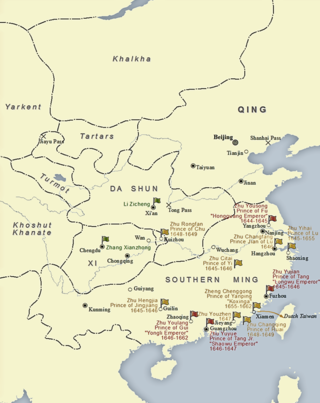This article needs additional citations for verification .(September 2018) |
| |||||
| Decades: | |||||
|---|---|---|---|---|---|
| See also: | Other events of 1647 History of China • Timeline • Years | ||||
Events from the year 1647 in China .
This article needs additional citations for verification .(September 2018) |
| |||||
| Decades: | |||||
|---|---|---|---|---|---|
| See also: | Other events of 1647 History of China • Timeline • Years | ||||
Events from the year 1647 in China .

Dorgon, was a Manchu prince and regent of the early Qing dynasty. Born in the House of Aisin-Gioro as the 14th son of Nurhaci, Dorgon started his career in military campaigns against the Mongols, the Koreans, and the Ming dynasty during the reign of Hong Taiji who succeeded their father.

The Shunzhi Emperor was the second emperor of the Qing dynasty of China, and the first Qing emperor to rule over China proper, reigning from 1644 to 1661. A committee of Manchu princes chose him to succeed his father, Hong Taiji (1592–1643), in September 1643, when he was five years old. The princes also appointed two co-regents: Dorgon (1612–1650), the 14th son of the Qing dynasty's founder Nurhaci (1559–1626), and Jirgalang (1599–1655), one of Nurhaci's nephews, both of whom were members of the Qing imperial clan.

Wu Sangui, courtesy name Changbai (長白) or Changbo (長伯), was a notorious Ming dynasty military officer who played a key role in the fall of the Ming dynasty and the founding of the Qing dynasty in China. In Chinese folklore, Wu Sangui is regarded as a disreputable Han Chinese traitor who played a pivotal role in several historical events, including the Battle of Shanhai Pass, Qing conquest of Ming China, the suppression of Southern Ming resistances and the execution of the Yongli Emperor, and eventually double-crossed both of his masters, the Ming and the Qing dynasties.

Oboi was a prominent Manchu military commander and courtier who served in various military and administrative posts under three successive emperors of the early Qing dynasty. Born to the Guwalgiya clan, Oboi was one of four regents nominated by the Shunzhi Emperor to oversee the government during the minority of the Kangxi Emperor. Oboi reversed the benevolent policies of the Shunzhi Emperor, and vigorously pushed for clear reassertion of Manchu power over the Han Chinese. Eventually deposed and imprisoned by the new emperor for having amassed too much power, he was posthumously rehabilitated.
The Chongzhen Emperor, personal name Zhu Youjian, courtesy name Deyue (德約), was the 17th and last emperor of the Ming dynasty. He reigned from 1627 to 1644. "Chongzhen", the era name of his reign, means "honorable and auspicious."

The Yongli Emperor, personal name Zhu Youlang, was the fourth and last emperor of the Southern Ming dynasty, reigning in turbulent times when the former Ming dynasty was overthrown and the Manchu-led Qing dynasty progressively conquered the entire China proper. He led the remnants of the Ming loyalists with the assistance of peasant armies to resist the Qing forces in southwestern China, but he was then forced to exile to Toungoo Burma and eventually captured and executed by Wu Sangui in 1662. His era title "Yongli" means "perpetual calendar".

Zhang Xianzhong, courtesy name Bingwu (秉吾), art name Jingxuan (敬軒), was a Chinese peasant leader who led a peasant rebellion from Yan'an wei, Shaanxi during the Ming-Qing transition. He conquered Sichuan in 1644, and named himself king and later emperor of the Xi dynasty. His rule in Sichuan was brief, and he was killed by the invading Qing army. He is commonly associated with the massacres in Sichuan that depopulated the region. However, the extent of his killings is disputed.

The Hongguang Emperor, personal name Zhu Yousong, childhood nickname Fuba (福八), was the first emperor of the Chinese Southern Ming dynasty. He reigned briefly in southern China from 1644 to 1645. His era name, "Hongguang", means "great light".
Zhu Yuyue, the Prince of Tang, reigned as the Shaowu Emperor of the Southern Ming dynasty from 1646 to 1647.
The Southern Ming, also known in historiography as the Later Ming, officially the Great Ming, was an imperial dynasty of China and a series of rump states of the Ming dynasty that came into existence following the Jiashen Incident of 1644. Peasant rebels led by Li Zicheng who founded the short-lived Shun dynasty captured Beijing and the Chongzhen Emperor committed suicide. The Ming general Wu Sangui then opened the gates of the Shanhai Pass in the eastern section of the Great Wall to the Qing banners, in hope of using them to annihilate the Shun forces. Ming loyalists fled to Nanjing, where they enthroned Zhu Yousong as the Hongguang Emperor, marking the start of the Southern Ming. The Nanjing regime lasted until 1645, when Qing forces captured Nanjing. Zhu fled before the city fell, but was captured and executed shortly thereafter. Later figures continued to hold court in various southern Chinese cities, although the Qing considered them to be pretenders.
Jirgalang or Jirhalang was a Manchu noble, regent, and political and military leader of the early Qing dynasty. Born in the Aisin Gioro clan, he was the sixth son of Šurhaci, a younger brother of Nurhaci, the founder of the Qing dynasty. From 1638 to 1643, he took part in many military campaigns that helped destroy the Ming dynasty. After the death of Huangtaiji in September 1643, Jirgalang became one of the young Shunzhi Emperor's two co-regents, but he soon yielded most political power to co-regent Dorgon in October 1644. Dorgon eventually purged him of his regent title in 1647. After Dorgon died in 1650, Jirgalang led an effort to clean the government of Dorgon's supporters. Jirgalang was one of ten "princes of the first rank" (和碩親王) whose descendants were made "iron-cap" princes (鐵帽子王), who had the right to transmit their princely titles to their direct male descendants perpetually.
This is a chronicle of important events that took place under the Shunzhi Emperor of the Qing dynasty (1636–1912). It spans from the death of his predecessor Hong Taiji in September 1643, to the emperor's own death on 5 February 1661, seven days into the eighteenth year of the Shunzhi reign period. These dates do not correspond perfectly with the Shunzhi era itself, which started on 8 February 1644—on New Year's Day of the lunisolar year following the emperor's accession—and ended on 17 February 1662, more than one solar year after the emperor's death. The posthumous events related to the Shunzhi Emperor's burial and posthumous cult are also included.

Li Dingguo, formally Prince of Jin, was a Chinese military general of the Southern Ming dynasty who fought against the Qing dynasty.

The transition from Ming to Qing or the Manchu conquest of China from 1618 to 1683 saw the transition between two major dynasties in Chinese history. It was a decades-long conflict between the emerging Qing dynasty, the incumbent Ming dynasty, and several smaller factions. It ended with the consolidation of Qing rule, and the fall of the Ming and several other factions.
Events from the year 1645 in China.

The Xi dynasty, officially the Great Xi, was a short-lived Chinese imperial dynasty that existed during the Ming–Qing transition. The dynasty, which lasted from 1643 to 1647, was established by the peasant rebellion leader Zhang Xianzhong, by proclaiming himself the title of the "king" (王) and later the "emperor" (皇帝) of the Great Xi, similar to the contemporary Shun dynasty established by another rebellion leader Li Zicheng. The Xi dynasty was based at Chengdu since 1644 with the era name "Dashun" and ruled most of Sichuan province, after Zhang Xianzhong seized the control of the province from the late Ming dynasty. During the regime's brief existence the province of Sichuan was greatly devastated and depopulated. The dynasty ended in 1647 after the death of Zhang Xianzhong, and its territory fell to the forces of the Southern Ming and the Manchu-led Qing dynasty.
Events from the year 1646 in China.
Events from the year 1662 in China.

The late Ming peasant rebellions were a series of peasant revolts during the last decades of the Ming dynasty lasting from 1628–1644. They were primarily caused by natural disasters in Shaanxi, Shanxi, and Henan. At the same time, the She-An Rebellion and Later Jin incursions forced the Ming government to cut funding for the postal service, which resulted in the mass unemployment of men in the provinces hit hard by natural disasters. Unable to cope with three major crises at the same time, the Ming dynasty collapsed in 1644.
Jianguo Lu was the regnal year of Zhu Yihai, Prince of Lu of the Southern Ming.